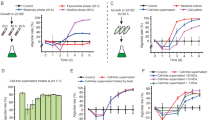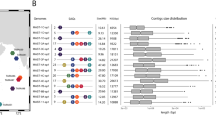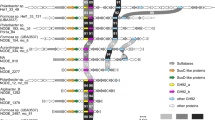Abstract
Deep-sea sediment is one of the most important microbial-driven ecosystems, yet it is not well characterized. Genome sequence analyses of deep-sea sedimentary bacteria would shed light on the understanding of this ecosystem. In this study, the complete genome of deep-sea sedimentary bacterium Pseudoalteromonas sp. SM9913 (SM9913) is described and compared with that of the closely related Antarctic surface sea-water ecotype Pseudoalteromonas haloplanktis TAC125 (TAC125). SM9913 has fewer dioxygenase genes than TAC125, indicating a possible sensitivity to reactive oxygen species. Accordingly, experimental results showed that SM9913 was less tolerant of H2O2 than TAC125. SM9913 has gene clusters related to both polar and lateral flagella biosynthesis. Lateral flagella, which are usually present in deep-sea bacteria and absent in the related surface bacteria, are important for the survival of SM9913 in deep-sea environments. With these two flagellar systems, SM9913 can swim in sea water and swarm on the sediment particle surface, favoring the acquisition of nutrients from particulate organic matter and reflecting the particle-associated alternative lifestyle of SM9913 in the deep sea. A total of 12 genomic islands were identified in the genome of SM9913 that may confer specific features unique to SM9913 and absent from TAC125, such as drug and heavy metal resistance. Many signal transduction genes and a glycogen production operon were also present in the SM9913 genome, which may help SM9913 respond to food pulses and store carbon and energy in a deep-sea environment.
Similar content being viewed by others
Log in or create a free account to read this content
Gain free access to this article, as well as selected content from this journal and more on nature.com
or
Accession codes
References
Apweiler R, Attwood TK, Bairoch A, Bateman A, Birney E, Biswas M et al. (2001). The InterPro database, an integrated documentation resource for protein families, domains and functional sites. Nucleic Acids Res 29: 37–40.
Atsumi T, McCarter L, Imae Y . (1992). Polar and lateral flagellar motors of marine Vibrio are driven by different ion-motive forces. Nature 355: 182–184.
Barrangou R, Fremaux C, Deveau H, Richards M, Boyaval P, Moineau S et al. (2007). CRISPR provides acquired resistance against viruses in prokaryotes. Science 315: 1709–1712.
Bendtsen JD, Nielsen H, Heijne GV, Brunak S . (2004). Improved prediction of signal peptides: SignalP 3.0. J Mol Biol 340: 783–795.
Boetius A, Ferdelman T, Lochte K . (2000). Bacterial activity in sediments of the deep Arabian Sea in relation to vertical flux. Deep-Sea Res. (II Top. Stud. Oceanogr.) 47: 2835–2875.
Brown MV, Philip GK, Bunge JA, Smith MC, Bissett A, Lauro FM et al. (2009). Microbial community structure in the North Pacific ocean. ISME J 3: 1374–1386.
Brunnegarda J, Grandel S, Stahl H, Tengberg A, Hall POJ . (2004). Nitrogen cycling in deep-sea sediments of the Porcupine Abyssal Plain, NE Atlantic. Progress in Oceanography 63: 159–181.
Chen XL, Zhang YZ, Gao PJ, Luan XW . (2003). Two different proteases produced by a deep-sea psychrotrophilc bacterial strain, Pseudoaltermonas sp. SM9913. Mar Biol 143: 989–993.
Cottrell MT, Wood DN, Yu L, Kirchman DL . (2000). Selected chitinase genes in cultured and uncultured marine bacteria in the alpha- and beta-subclasses of the proteobacteria. Appl Environ Microbiol 66: 1195–1201.
Cui Z, Lai Q, Dong C, Shao Z . (2008). Biodiversity of polycyclic aromatic hydrocarbon-degrading bacteria from deep sea sediments of the Middle Atlantic Ridge. Environ Microbiol 10: 2138–2149.
Dang HY, Zhu H, Wang J, Li T . (2009). Extracellular hydrolytic enzyme screening of culturable heterotrophic bacteria from deep-sea sediments of the Southern Okinawa Trough. World J Microb Biot 25: 71–79.
Delcher AL, Harmon D, Kasif S, White O, Salzberg SL . (1999). Improved microbial gene identification with GLIMMER. Nucleic Acids Res 27: 4636–4641.
Eloe EA, Lauro FM, Vogel RF, Bartlett DH . (2008). The deep-sea bacterium Photobacterium profundum SS9 utilizes separate flagellar systems for swimming and swarming under high-pressure conditions. Appl Environ Microbiol 74: 6298–6305.
Ghysels B, Ochsner U, Mollman U, Heinisch L, Vasil M, Cornelis P et al. (2005). The Pseudomonas aeruginosa pirA gene encodes a second receptor for ferrienterobactin and synthetic catecholate analogues. FEMS Microbiol Lett 246: 167–174.
Glud RN . (2008). Oxygen dynamics of marine sediments. Mar Biol Res 4: 243–289.
Gordon D, Abajian C, Green P . (1998). Consed: a graphical tool for sequence finishing. Genome Res 8: 195–202.
Griffiths-Jones S, Bateman A, Marshall M, Khanna A, Eddy SR . (2003). Rfam: an RNA family database. Nucleic Acids Res 31: 439–441.
Hjerde E, Lorentzen MS, Holden MTG, Seeger K, Paulsen S, Bason N et al. (2008). The genome sequence of the fish pathogen Aliivibrio salmonicida strain LFI1238 shows extensive evidence of gene decay. BMC Genomics 9: 616.
Holmstrom C, kjelleberg S . (1999). Marine Pseudoalteromonas species are associated with higher organisms and produce biologically active extracellular agents. FEMS Microbiol Ecol 30: 285–293.
Hou S, Saw JH, Lee KS, Freitas TA, Belisle C, Kawarabayasi Y et al. (2004). Genome sequence of the deep-sea gamma-proteobacterium Idiomarina loihiensis reveals amino acid fermentation as a source of carbon and energy. Proc Natl Acad Sci USA 101: 18036–18041.
Ivars-Martinez E, Martin-Cuadrado A, Auria GD, Mira A, Ferriera S, Johnson J et al. (2008). Comparative genomics of two ecotypes of the marine planktonic copiotroph Alteromonas macleodii suggests alternative lifestyles associated with different kinds of particulate organic matter. ISME J 2: 1194–1212.
Jørgensen BB, Boetius A . (2007). Feast and famine-microbial life in the deep-sea bed. Nat Rev Microbiol 5: 770–781.
Karlin S . (2001). Detecting anomalous gene clusters and pathogenicity islands in diverse bacterial genomes. Trends Microbiol 9: 335–343.
Kettler GC, Martiny AC, Huang K, Zucker J, Coleman ML, Rodrigue S et al. (2007). Patterns and implications of gene gain and loss in the evolution of prochlorococcus. PLoS Genet 3: e231.
Konstantinidis KT, Braff J, Karl DM, Delong EF . (2009). Comparative metagenomic analysis of a microbial community residing at a depth of 4000 meters at station ALOHA in the north pacific subtropical gyre. Appl Environ Microbiol 75: 5345–5355.
Konstantinidis KT, Tiedje JM . (2005). Genomic insights that advance the species definition for prokaryotes. Proc Natl Acad Sci USA 102: 2567–2572.
Lauro FM, Chastain RA, Blankenship LE, Yayanos AA, Bartlett DH . (2007). The unique 16S rRNA genes of piezophiles reflect both phylogeny and adaptation. Appl Environ Microbiol 73: 838–845.
Lauro FM, Tran K, Vezzi A, Vitulo N, Valle G, Bartlett DH . (2008). Large-scale transposon mutagenesis of Photobacteriumprofundum SS9 reveals new genetic loci important for growth at low temperature and high pressure. J Bacteriol 190: 1699–1709.
Lowe TM, Eddy SR . (1997). tRNAscan-SE: a program for improved detection of transfer RNA genes in genomic sequence. Nucleic Acids Res 25: 955–964.
Médigue C, Krin E, Pascal G, Barbe V, Bernsel A, Bertin PN et al. (2005). Coping with cold: the genome of the versatile marine Antarctica bacterium Pseudoalteromonas haloplanktis TAC125. Genome Res 15: 1325–1335.
Moeck GS, Coulton JW . (1998). TonB-dependent iron acquisition: mechanisms of siderophore-mediated active transport. Mol Microbiol 28: 675–681.
Nichols CA, Guezennec J, Bowman JP . (2005). Bacterial exopolysaccharides from extreme marine environments with special consideration of the southern ocean, sea ice, and deep-sea hydrothermal vents: a review. Mar Biotechnol 7: 253–271.
Nishino K, Yamaguchi A . (2001). Analysis of a complete library of putative drug transporter genes in Escherichia coli. J Bacteriol 183: 5803–5812.
Pfannkuche O . (1992). Benthic response to the sedimentation of particulate organic matter at the BIOTRANS station, 47°N, 20°W. DS Res II—Deep-Sea Res 40: 135–149.
Preiss J . (1984). Bacterial glycogen synthesis and its regulation. Annu Rev Microbiol 38: 419–458.
Qin GK, Zhu L, Chen XL, Wang PG, Zhang YZ . (2007a). Structural characterization and ecological roles of a novel exopolysaccharide from the deep-sea psychrotolerant bacterium Pseudoalteromonas sp. SM9913. Microbiology 153: 1566–1572.
Qin QL, Zhao DL, Wang J, Chen XL, Dang HY, Li TG et al. (2007b). Wangia profunda gen. nov., sp. nov., a novel marine bacterium of the family Flavobacteriaceae isolated from southern Okinawa Trough deep-sea sediment. FEMS Microbiol Lett 271: 53–58.
Rice PA, Baker TA . (2001). Comparative architecture of transposase and integrase complexes. Nat Struct Biol 8: 302–307.
Römling U . (2009). Rationalizing the evolution of EAL domain-based cyclic di-GMP-specific phosphodiesterases. J Bacteriol 191: 4697–4700.
Römling U, Gomelsky M, Galperin MY . (2005). C-di-GMP: the dawning of a novel bacterial signalling system. Mol Microbiol 57: 629–639.
Rutherford K, Parkhill J, Crook J, Horsnell T, Rice P, Rajandream MA et al. (2000). Artemis: sequence visualization and annotation. Bioinformatics 16: 944–945.
Schippers A, Neretin LN, Kallmeyer J, Ferdelman TG, Cragg BA, Parkes RJ et al. (2005). Prokaryotic cells of the deep sub-seafloor biosphere identified as living bacteria. Nature 433: 861–864.
Smith CR, De Leo FC, Bernardino AF, Sweetman AK, Arbizu PM . (2008). Abyssal food limitation, ecosystem structure and climate change. Trends Ecol Evol 23: 518–528.
Sogin ML, Morrison HG, Huber JA, Welch DM, Huse SM, Neal PR et al. (2006). Microbial diversity in the deep sea and the underexplored ‘rare biosphere’. Proc Natl Acad Sci USA 103: 12115–12120.
Sorek R, Kunin V, Hugenholtz P . (2008). CRISPR—a widespread system that provides acquired resistance against phages in bacteria and archaea. Nat Rev Microbiol 6: 181–186.
Strange RE . (1968). Bacterial ‘glycogen’ and survival. Nature 220: 606–607.
Suttle C . (2005). Viruses in the sea. Nature 437: 356–361.
Suttle C . (2007). Marine viruses—major players in the global ecosystem. Nat Rev Microbiol 5: 801–812.
Tatusova RL, Natale DA, Garkavtsev IV, Tatusova TA, Shankavaram UT, Rao BS et al. (2001). The COG database: new developments in phylogenetic classification of proteins from complete genomes. Nucleic Acids Res 29: 22–28.
Ting CS, Rocap G, King J, Chisholm SW . (2002). Cyanobacterial photosynthesis in the oceans: the origins and significance of divergent light-harvesting strategies. Trends Microbiol 10: 134–142.
Thomas T, Evans FF, Schleheck D, Mai-Prochnow A, Burke C, Penesyan A et al. (2008). Analysis of the Pseudoalteromonas tunicata genome reveals properties of a surface-associated life style in the marine environment. PLoS One 3: e3252.
Toffin L, Webster G, Weightman AJ, Fry JC, Prieur D . (2004). Molecular monitoring of culturable bacteria from deep-sea sediment of the Nankai Trough, Leg 190 Ocean Drilling Program. FEMS Microbiol Ecol 48: 357–367.
Turley C . (2000). Bacteria in the cold deep-sea benthic boundary layer and sediment-water interface of the NE Atlantic. FEMS Microbiol Ecol 33: 89–99.
Vezzi A, Campanaro S, D’Angelo M, Simonato F, Vitulo N, Lauro FM et al. (2005). Life at depth: Photobacterium profundum genome sequence and expression analysis. Science 307: 1459–1461.
Wang F, Wang J, Jian H, Zhang B, Li S, Wang F et al. (2008). Environmental adaptation: genomic analysis of the piezotolerant and psychrotolerant deep-sea iron reducing bacterium Shewanella piezotolerans WP3. PLoS One 3: e1937.
Whitman WB, Coleman DC, Wiebe WJ . (1998). Prokaryotes: The unseen majority. Proc Natl Acad Sci USA 95: 6578–6583.
Witte U, Aberle N, Sand M, Wenzhöfer F . (2003a). Rapid response of a deep-sea benthic community to POM enrichment: an in situ experimental study. Mar Ecol Prog Ser 251: 27–36.
Witte U, Wenzhofer F, Sommer S, Boetius A, Heinz P, Aberle N et al. (2003b). In situ experimental evidence of the fate of a phytodetritus pulse at the abyssal sea floor. Nature 424: 763–766.
Zhao GY, Chen XL, Zhao HL, Xie BB, Zhou BC, Zhang YZ . (2008). Hydrolysis of insoluble collagen by deseasin MCP-01 from deep-sea Pseudoalteromonas sp. SM9913: Collagenolytic characters, collagen-binding ability of C-terminal PKD domain and Implication for its novel role in deep-sea sedimentary particulate organic nitrogen degradation. J Biol Chem 283: 36100–36107.
Zhou MY, Chen XL, Zhao HL, Dang HY, Luan WX, Zhang XY et al. (2009). Diversity of both the cultivable protease-producing bacteria and their extracellular proteases in the sediments of the South China Sea. Microb Ecol 58: 582–590.
Acknowledgements
We thank Yi Ren for his help in sequence assembly and data analysis. The work was supported by National Natural Science Foundation of China (30770040), Hi-Tech Research and Development program of China (2007AA091903, 2007AA021306) and COMRA Program (DYXM-115-02-2-6).
Author information
Authors and Affiliations
Corresponding author
Additional information
Supplementary Information accompanies the paper on The ISME Journal website
Supplementary information
Rights and permissions
About this article
Cite this article
Qin, QL., Li, Y., Zhang, YJ. et al. Comparative genomics reveals a deep-sea sediment-adapted life style of Pseudoalteromonas sp. SM9913. ISME J 5, 274–284 (2011). https://doi.org/10.1038/ismej.2010.103
Received:
Revised:
Accepted:
Published:
Issue date:
DOI: https://doi.org/10.1038/ismej.2010.103
Keywords
This article is cited by
-
New investigation of encoding secondary metabolites gene by genome mining of a marine bacterium, Pseudoalteromonas viridis BBR56
BMC Genomics (2024)
-
Community composition, co-occurrence, and environmental drivers of bacterioplankton community in surface and 50-m water layers in the subarctic North Pacific
Journal of Oceanology and Limnology (2023)
-
A pathway for chitin oxidation in marine bacteria
Nature Communications (2022)
-
Scientific and technological progress in the microbial exploration of the hadal zone
Marine Life Science & Technology (2022)
-
Mono- and multispecies biofilms from a crustose coralline alga induce settlement in the scleractinian coral Leptastrea purpurea
Coral Reefs (2021)



